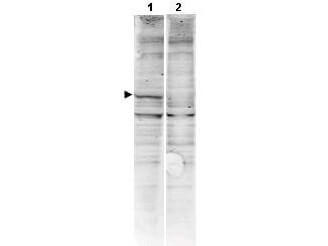Anti-CaM Kinase II (RABBIT) Antibody
CaM Kinase II Antibody
- SPECIFICATION
- CITATIONS
- PROTOCOLS
- BACKGROUND

| Host | Rabbit |
|---|---|
| Conjugate | Unconjugated |
| Target Species | Human |
| Reactivity | Mouse |
| Clonality | Polyclonal |
Application
| WB, E, I, LCI |
| Application Note | This affinity purified antibody has been tested for use in ELISA and western blot. Specific conditions for reactivity should be optimized by the end user. Expect a band ~ 54 kDa in size corresponding to CaM Kinase II by western blotting in the appropriate cell lysate or extract. |
| Physical State | Liquid (sterile filtered) |
| Buffer | 0.02 M Potassium Phosphate, 0.15 M Sodium Chloride, pH 7.2 |
| Immunogen | This affinity purified antibody was prepared from whole rabbit serum produced by repeated immunizations with a synthetic peptide corresponding to an N-terminus region of Human CaM Kinase II protein. |
| Preservative | 0.01% (w/v) Sodium Azide |
| Gene ID | 815 |
|---|---|
| Other Names | 815 |
| Purity | This affinity purified antibody is directed against human CaM Kinase II protein. The product was affinity purified from monospecific antiserum by immunoaffinity purification. A BLAST analysis was used to suggest reactivity with this protein from human, mouse, rat, and orangutan based on 100% homology for the immunogen sequence. Cross reactivity with CaM Kinase II protein from zebrafish and rabbit may occur as this sequence only varies by one amino acid residue (94% homology). Cross reactivity with CaM Kinase II homologues from other sources has not been determined. |
| Storage Condition | Store vial at -20° C prior to opening. Aliquot contents and freeze at -20° C or below for extended storage. Avoid cycles of freezing and thawing. Centrifuge product if not completely clear after standing at room temperature. This product is stable for several weeks at 4° C as an undiluted liquid. Dilute only prior to immediate use. |
| Precautions Note | This product is for research use only and is not intended for therapeutic or diagnostic applications. |
| Name | CAMK2A |
|---|---|
| Synonyms | CAMKA, KIAA0968 |
| Function | Calcium/calmodulin-dependent protein kinase that functions autonomously after Ca(2+)/calmodulin-binding and autophosphorylation, and is involved in various processes, such as synaptic plasticity, neurotransmitter release and long-term potentiation (PubMed:14722083). Member of the NMDAR signaling complex in excitatory synapses, it regulates NMDAR-dependent potentiation of the AMPAR and therefore excitatory synaptic transmission (By similarity). Regulates dendritic spine development (PubMed:28130356). Also regulates the migration of developing neurons (PubMed:29100089). Phosphorylates the transcription factor FOXO3 to activate its transcriptional activity (PubMed:23805378). Phosphorylates the transcription factor ETS1 in response to calcium signaling, thereby decreasing ETS1 affinity for DNA (By similarity). In response to interferon-gamma (IFN-gamma) stimulation, catalyzes phosphorylation of STAT1, stimulating the JAK- STAT signaling pathway (PubMed:11972023). In response to interferon- beta (IFN-beta) stimulation, stimulates the JAK-STAT signaling pathway (PubMed:35568036). Acts as a negative regulator of 2- arachidonoylglycerol (2-AG)-mediated synaptic signaling via modulation of DAGLA activity (By similarity). |
| Cellular Location | Synapse {ECO:0000250|UniProtKB:P11275}. Postsynaptic density {ECO:0000250|UniProtKB:P11275}. Cell projection, dendritic spine. Cell projection, dendrite. Note=Postsynaptic lipid rafts {ECO:0000250|UniProtKB:P11275} |

Thousands of laboratories across the world have published research that depended on the performance of antibodies from Abcepta to advance their research. Check out links to articles that cite our products in major peer-reviewed journals, organized by research category.
info@abcepta.com, and receive a free "I Love Antibodies" mug.
Provided below are standard protocols that you may find useful for product applications.
Background
CaM Kinase II (also known as CAMK2 and calcium/calmodulin-dependent protein kinase type II alpha chain) is a prominent kinase in the central nervous system that may function in the long-term potentiation of neurotransmitter release. CaM Kinase II autophosphorylates itself at Thr-286 which allows the kinase to switch from a calmodulin-dependent to a calmodulin-independent state. CaM Kinase II is composed of four different chains: alpha, beta, gamma, and delta. The different isoforms assemble into homo- or heteromultimeric holoenzymes composed of 8 to 12 subunits. This kinase is expressed in brain tissue. Alternative splicing occurs for this gene product.
If you have used an Abcepta product and would like to share how it has performed, please click on the "Submit Review" button and provide the requested information. Our staff will examine and post your review and contact you if needed.
If you have any additional inquiries please email technical services at tech@abcepta.com.













 Foundational characteristics of cancer include proliferation, angiogenesis, migration, evasion of apoptosis, and cellular immortality. Find key markers for these cellular processes and antibodies to detect them.
Foundational characteristics of cancer include proliferation, angiogenesis, migration, evasion of apoptosis, and cellular immortality. Find key markers for these cellular processes and antibodies to detect them. The SUMOplot™ Analysis Program predicts and scores sumoylation sites in your protein. SUMOylation is a post-translational modification involved in various cellular processes, such as nuclear-cytosolic transport, transcriptional regulation, apoptosis, protein stability, response to stress, and progression through the cell cycle.
The SUMOplot™ Analysis Program predicts and scores sumoylation sites in your protein. SUMOylation is a post-translational modification involved in various cellular processes, such as nuclear-cytosolic transport, transcriptional regulation, apoptosis, protein stability, response to stress, and progression through the cell cycle. The Autophagy Receptor Motif Plotter predicts and scores autophagy receptor binding sites in your protein. Identifying proteins connected to this pathway is critical to understanding the role of autophagy in physiological as well as pathological processes such as development, differentiation, neurodegenerative diseases, stress, infection, and cancer.
The Autophagy Receptor Motif Plotter predicts and scores autophagy receptor binding sites in your protein. Identifying proteins connected to this pathway is critical to understanding the role of autophagy in physiological as well as pathological processes such as development, differentiation, neurodegenerative diseases, stress, infection, and cancer.


